Broan F402404 Handleiding
Bekijk gratis de handleiding van Broan F402404 (8 pagina’s), behorend tot de categorie Afzuigkap. Deze gids werd als nuttig beoordeeld door 23 mensen en kreeg gemiddeld 4.9 sterren uit 12 reviews. Heb je een vraag over Broan F402404 of wil je andere gebruikers van dit product iets vragen? Stel een vraag
Pagina 1/8

INSTALLER: Leave This
Manual With
The Homeowner. HOME-
OWNER:
Use and Care Information on
Page 5.
INSTALADOR: Deje este
manual con el dueño de la
casa. DUEÑO DE LA CASA:
Información acerca del uso y
los cuidados en la Página 5.
READ AND SAVE
THESE INSTRUCTIONS
WARNING
TO REDUCE THE RISK OF FIRE, ELECTRIC SHOCK,
OR INJURY TO PERSONS, OBSERVE THE FOLLOW-
ING:
1. Use this unit only in the manner intended by the manu-
facturer. If you have questions, contact the manufac-
turer at the address or telephone number listed in
the warranty.
2. Before servicing or cleaning unit, switch power off at
service panel and lock the service disconnecting
means to prevent power from being switched on ac-
cidentally. When the service disconnecting means
cannot be locked, securely fasten a prominent warn-
ing device, such as a tag, to the service panel.
3. Installation work and electrical wiring must be done
by a qualified person(s) in accordance with all appli-
cable codes and standards, including fire-rated con-
struction codes and standards.
4. Sufficient air is needed for proper combustion and ex-
hausting of gases through the flue (chimney) of fuel
burning equipment to prevent backdrafting. Follow the
heating equipment manufacturer’s guideline and safety
standards such as those published by the National
Fire Protection Association (NFPA), and the American
Society for Heating, Refrigeration and Air Condition-
ing Engineers (ASHRAE), and the local code authori-
ties.
5. When cutting or drilling into wall or ceiling, do not dam-
age electrical wiring and other hidden utilities.
6. Ducted fans must always be vented to the outdoors.
7. Do not use this unit with any solid-state speed con-
trol device.
8. To reduce the risk of fire, use only metal ductwork.
9. Use with approved cord-connection kit only.
10.This unit must be grounded.
TO REDUCE THE RISK OF A RANGE TOP GREASE
FIRE:
1. Never leave surface units unattended at high settings.
Boilovers cause smoking and greasy spillovers that
may ignite. Heat oils slowly on low or medium set-
tings.
2. Always turn hood ON when cooking at high heat or
when cooking flaming foods.
3. Clean ventilation fans frequently. Grease should not
be allowed to accumulate on fan or filter.
4. Use proper pan size. Always use cookware appropri-
ate for the size of the surface element.
TO REDUCE THE RISK OF INJURY TO PERSONS IN
THE EVENT OF A RANGE TOP GREASE FIRE, OB-
SERVE THE FOLLOWING:*
1. SMOTHER FLAMES with a close-fitting lid, cookie
sheet, or metal tray, then turn off the burner. BE CARE-
FUL TO PREVENT BURNS. If the flames do not go out
immediately, EVACUATE AND CALL THE FIRE DE-
PARTMENT.
2. NEVER PICK UP A FLAMING PAN - You may be
burned.
3. DO NOT USE WATER, including wet dishcloths or
towels - a violent steam explosion will result.
4. Use an extinguisher ONLY if:
A. You know you have a Class ABC extinguisher and
you already know how to operate it.
B. The fire is small and contained in the area where it
started.
IMPORTANT
For Non-ducted (Ductfree) Installation:
a) Purchase non-ducted filter separately.
b) Remove and discard damper/duct connector and
louver cover (See Step 4) in “Prepare the Hood,”
Page 2.
c) Follow all steps except steps inside dotted lines.
For Ducted Installation:
Follow all steps, including steps inside dotted lines.
F40000 SERIES
4-WAY CONVERTIBLE
RANGE HOOD
LEA Y CONSERVE
ESTAS INSTRUCCIONES
IMPORTANTE
Para instalación sin ducto:
a) Compra el filtro sin conductos separado.
b) Quite y descarte el conector del regulador/ducto y la
tapa de la rejilla (Véase paso 4) en la Página 2 titulada
“Prepare el extractor.”
c) Siga todos los pasos excepto de los pasos dentro las
líneas suspensivas.
Para instalación con ducto:
Siga todos los pasos incluyendo los pasos dentro de
las líneas suspensivas.
ADVERTENCIA
PARA REDUCIR EL RIESGO DE INCENDIO, CHOQUE ELEC-
TRICO, O LESION A PERSONAS, PROCURE LO SIGUIEN-
TE:
1. Utilice esta unidad sólo en la manera prescrita por el fabricante.
Si tiene usted alguna pregunta, comuníquese con el fabricante
a la dirección o el teléfono indicados en la garantía.
2. Antes de limpiar o de poner en servicio la unidad, apague el
interruptor en el panel de servicio, y asegure el panel de
servicio para evitar que se encienda accidentalmente. Cuando
el dispositivo para desconectar el servicio eléctrico no puede
ser cerrado con algún tipo de traba, sujete fuertemente al
panel de servicio, una etiqueta de advertencia prominente.
3. Todo trabajo de instalación y cableado eléctrico debe ser
realizado por personal calificado y de acuerdo con todos los
códigos y normas pertinentes, incluyendo los códigos y normas
relacionados con construcción clasificada para incendio.
4. Aire suficiente es necesario para facilitar la combustión
adecuada y la salida apropiada de gases por la chimenea de
la unidad y para evitar corrientes de aire invertidas. Siga las
instrucciones y medidas de seguridad del fabricante del equipo
y de las sociedades profesionales de equipos de calentadores
y los reglamentos de seguridad locales.
5. A cortar o perforar la pared o el techo, no dañe el cableado
eléctrico u otros servicios públicos ocultos a la vista.
6. Los abanicos con ducto deberán siempre tener una salida
hacia el exterior.
7. No utilice esta unidad en conjunto con cualquier dispositivo
de control de velocidad de estado sólido.
8. Para reducir el riesgo de incendio, use sólo ductos de metal.
9. Uso con el kit aprobado del la conexión de la cuerda
solamente.
10. Esta unidad se debe instalar con tierra efectiva.
PARA REDUCIR EL RIESGO DE UN INCENDIO POR GRASA
EN EN LA ESTUFA:
1. Nunca deje sin atender las unidades de superficie cuando
tengan ajustes altos. Los reboses pueden provocar humo y
derrames grasosos que se pueden incendiar. Caliente
lentamente el aceite en un ajuste bajo o medio.
2. Siempre ENCIENDA la campana cuando cocine con alta
temperatura o cuando cocine alimentos que se puedan
incendiar.
3. Limpie con frecuencia los ventiladores. No debe permitir que
la grasa se acumule en el ventilador ni en el filtro.
4. Utilice un sartén de tamaño adecuado. Siempre utilice el
utensilio adecuado al tamaño del elemento de superficie.
PARA REDUCIR EL RIESGO DE LESION A PERSONAS RE-
SULTADO DE UN INCENDIO DEBIDO A GRASA ACUMULADA
EN LAS HORNILLAS, PROCURE LO SIGUIENTE:*
1.
AHOGUE LAS LLAMAS con una tapa ajustada o charola de metal,
después apague la hornilla. TENGA CUIDADO A FIN DE EVITAR
QUEMADURAS. Si las llamas no se apagan de inmediato,
EVACUE Y AVISE A LOS BOMBEROS.
2. NO LEVANTE NUNCA UNA SARTEN QUE ESTE EN
LLAMAS - Usted se podrá quemar.
3. NO UTILICE AGUA, incluyendo toallas de cocina mojadas -
puede resultar una explosión de vapor violenta.
4. Utilice un extinguidor SOLAMENTE si:
A. Usted sabe que tiene un extinguidor de clase
ABC y lo sabe utilizar.
B. El incendio es pequeño y contenido dentro del
área donde se inició.
C. Los bomberos han sido avisados.
D. Usted puede combatir el incendio con una salida a
su espalda.
* Basado en las recomendaciones para “Seguridad en la
Cocina” publicadas por la NFPA de los EEUU.
CAMPANA EXTRACTORA
4-WAY CONVERTIBLE
SERIE F40000
!
INTENDED FOR DOMESTIC
COOKING ONLY.
!
!
PREVISTO PARA COCINAR
DOMÉSTICO SOLAMENTE.
!

C. The fire department is being called.
D. You can fight the fire with your back to an exit.
* Based on “Kitchen Fire Safety Tips” published by
NFPA.
CAUTION
!
1. For general ventilating use only. Do not use to
exhaust hazardous or explosive materials and
vapors.
2. To avoid motor bearing damage and noisy and/
or unbalanced impellers, keep drywall spray,
construction dust, etc. off power unit.
3. Your hood motor has a thermal overload which will
automatically shut off the motor if it becomes
overheated. The motor will restart when it cools
down. If the motor continues to shut off and restart,
have the hood serviced.
4. For best capture of cooking impurities, your range hood
should be mounted 18-24" above the cooking surface.
5. Please read specification label on product for further
information and requirements.
FIG. 1B
FIG. 1C
FIG. 1D
FIG. 1E
2
6" ROUND DUCT 406
DUCTO REDONDO DE
6" 406
3-1/4" x 10" TO 6"
ROUND DUCT
TRANSITION 411
TRANSICIÓN DE
3-1/4" x 10" A
UN DUCTO
REDONDO
DE 6" 411
WALL CAP 639 OR 649
CASQUETE DE PARED 639 O 649
WALL CAP 639 OR 649
CASQUETE DE PARED
639 O 649
3-1/4" x 10" DUCT 401
DUCTO DE 3-1/4" x 10" 401
ROOF CAP 634 OR 644
CASQUETE DE
TECHO 634 O 644
3-1/4" x 10" DUCT 401
DUCTO DE
3-1/4" x 10" 401
ADJUSTABLE ELBOW 419
CODO AJUSTABLE 419
WALL CAP 641
CASQUETE DE
PARED 641
3-1/4" x 10" TO 6"
ROUND DUCT
TRANSITION 411
TRANSICIÓN DE
3-1/4" x 10" A
UN DUCTO
REDONDO
DE 6" 411
ROOF CAP 634 OR 644
CASQUETE DE TECHO 634 O 644
6" ROUND
DUCT 406
DUCTO
REDONDO
DE 6" 406
PRECAUCION
!
1. Solamente para uso general de ventilación. No utilice para
descargar materiales o vapores riesgosos o explosivos.
2. Para evitar daños al motor y evitar que las navajas del
abanico emitan mucho ruido o estén fuera de balance,
mantenga el motor libre de pelusa, polvo, etc.
3. El motor de su extractor tiene dispositivo de sobrecarga
térmica, al cual automáticamente apagará el motor si
se sobrecalienta. El motor funcionará de nuevo cuando
se enfríe. Si el motor continua apagándose y arrancando,
hágalo componer.
4. Para obtener mejores resultados en la captura de los
vapores de la estufa, el extractor debe montarse a entre
18 y 24 plg. sobre las hornillas de la estufa.
5. Por favor lea la etiqueta con las especificaciones del
equipo para otros requisitos y mayor información.
HERRAMIENTAS Y
MATERIALES QUE SE
REQUIEREN
HERRAMIENTAS
❏Taladro, eléctrico o trinquete
❏Broca tipo pala de 1-1/4"
❏Destornillador de ranura o tipo phillips
❏Pinzas o tenazas
❏Medidor de cinta o regla y lápiz
Para instalaciones con ducto SOLAMENTE:
❏Sierra tipo sable o sierra para tabiques
❏Alicate para cortar
MATERIALES
❏Suministros y alambre eléctrico del tipo que cumplen
con los códigos locales
❏Casquete de techo o pared
❏Cemento o pega de techa o material de calafatear
o rellenar
❏Ductos y cinta aislante para ductos
Para instalación en gabinetes de cocina con la parte infe-
rior ahuecada solamente:
❏Dos tiras de madera 1" x 2" x 12" (largo aproximado)
(cómpreselas localmente)
❏Cuatro tornillos para madera de cabeza plana de 1-1/4"
de largo (cómpreselas localmente) para sujetar las tiras
de madera a la parte inferior de gabinete
PLANIFICANDO LA
INSTALACION DE LOS
DUCTOS
Comience el trabajo de los ductos decidiendo el camino
que el ducto tomará entre el extractor y la parte exterior
de la casa. Para mejor rendimiento, use el camino de ducto
más corto posible y un mínimo de codos. Se muestran
varias elecciones - FIGS. 1A - 1E.
En situaciones de paso del ducto más complejas, el ex-
tractor con conexión para ducto rectangular puede
convertirse en conexión redonda usando una transición.
FIG. 1A. Pasando el ducto directamente a través de la
pared (para los extractores que están instalados en una
pared exterior). Se muestran dos maneras de pasar el
ducto a través de la pared exterior. Si se usa un casquete
de pared directamente en la parte de atrás del extractor
hay que asegurarse que el regulador en el conector entre
ducto y regulador en el extractor, y el regulador en el
casquete de pared no interfieran el uno con el otro cuando
el extractor esté operando. Esto podría resultar en paso
de aire inadecuado o corrientes invertidas. Si esta
condición existe, quite la hoja instalada en el regulador
del extractor. A veces cuando se usa un casquete de pared
es más fácil pasar el ducto verticalmente y usar un codo
como se muestra en FIG. 1B.
FIG. 1C. Haciendo un ducto directamente al techo usando
un ducto rectangular de 3-1/4" x 10" (para instalaciones
en un piso solamente).
FIG. 1D. Instalando un ducto entre las vigas del techo
(para instalaciones en más de un piso) o a través del
espacio de sofito arriba de los gabinetes (cuando el sofito
está conectado a una pared exterior).
FIG. 1E. Directamente hacia el techo usando transición
de 3-1/4” x 10” a un ducto redondo de 6” y ducto redondo
de 6" (para instalaciones de un piso).
FIG. 1F. Directamente hacia el techo usando ducto
redondo de 7" (para instalaciones de un piso).
TOOLS AND
MATERIALS REQUIRED
TOOLS
❏Drill, electric or ratchet drive
❏1-1/4" Spade bit
❏Common head and phillips head screwdriver
❏Pliers
❏Tape measure or ruler and pencil
For Ducted Installations ONLY:
❏Saber saw or drywall saw
❏Metal snips
MATERIALS
❏Electrical wiring and supplies of type to comply
with local codesFor Ducted Installations Only:
❏Roof or wall cap
❏Roof cement or caulk
❏Duct and duct tape
For Installation on Kitchen Cabinets with Recessed
Bottoms Only:
❏Two 1" x 2" x 12" (approximate length) wood strips
(purchase locally)
❏Four 1-1/4" long flat head wood screws (purchase
locally) to fasten strips to cabinet bottom
PLANNING DUCTWORK
INSTALLATION
Begin planning ductwork by deciding where the duct
will run between the range hood and the outside. For
best performance, use the shortest possible duct run
and a minimum number of elbows. There are several
choices shown - FIGS. 1A - 1E.
In more complex ducting situations, a 3-1/4" rectan-
gular ducting range hood can be converted to a round
duct by means of a transition.
FIG. 1A. Ducting directly through the wall (for range
hoods mounted on an exterior wall). Shown are two
ways to duct through an outside wall. If a wall cap is
used directly off the back of the hood, special care
must be taken to make sure that the damper in the
damper/duct connector on the hood and damper in
the wall cap do not interfere with each other when the
hood is operating. This could result in either inad-
equate air delivery or back drafts. If this condition does
exist, remove the hood damper flap. Sometimes when
using a wall cap it is easier to duct vertically and then
use an elbow as shown in FIG. 1B.
FIG. 1C. Ducting straight up through the roof using
3-1/4" x 10" rectangular duct. (For single story in-
stallations.)
FIG. 1D. Ducting between the ceiling joists (for multi-
story installations) or through the soffit space above
the cabinets (where the soffit connects to an outside
wall).
FIG. 1E. Straight up through the roof using 3-1/4” x
10” to 6” round duct transition and 6" round duct (for
single-story installations).
FIG. 1F. Straight up through the roof using 7" round
duct (for single-story installations).
FIG. 1A
7" ROUND DUCT 407
DUCTO REDONDO
DE 7” 407
MODEL BP87
DAMPER
REGISTRO
DE TIRO
MODELO BP87
ROOF CAP 634
CASQUETE DE
TECHO 634
FIG. 1F

3
FIG. 2
FIG. 5
FIG. 6
FIG. 7
CUT STRIPS TO FIT
CORTE LAS TIRAS PARA
QUE QUEPAN
CENTER LINE
LINEA CENTRICA
WIDTH OF
RANGE HOOD
ANCHO DEL
EXTRACTOR
ELECTRICAL WIRING OPENING
ABERTURA PARA EL
CABLEADO ELECTRICO
PREPARANDO EL EXTRACTOR
1. Desempaque el extractor y revise el contenido de la
caja. Usted debe de encontrar:
1 - Filtro de aluminio
1 - Conector de ducto/regulador de 3-1/4" x 10"
(montado dentro del extractor para embarque
solamente) (Guarde los tornillos para el monta-
je.)
1 - Placa del conducto redondo de 7” (montado en
del extractor) (no se muestra) (Guarde los torni-
llos para el montaje.)
2. Quite la placa del conducto redondo de 7” de la parte
superior de la campana. Colóquela aparte, con los
tornillos de montaje.
3. Quite la cubierta de la caja de cableado. Bajo la tapa
encontrará:
1 - Una bolsa de plástico que contiene herrajes
sueltos para instalación
Para instalaciones sin ducto SOLAMENTE:
4. Para instalaciones sin ducto, quite la tapa de la reji-
llas de la parte frontal del extractor. (FIG. 3)
NOTA
Las rejillas que se encuentran al frente de la campana
deben estar abiertas y visibles para que la campana
funcione sin conducto.
5. Quite la tapa de quitar golpeando eléctrica de arriba
o atrás dependiendo en donde entra el cableado al
extractor de la pared o del gabinete. (FIG. 4)
INSTALACION CON DUCTO SOLAMENTE
NOTA
La cubierta de las rejillas se debe instalar como se
muestra en la figura 3 para que funcione con el
conducto.
6. Quite la placa de quitar golpeando en el extractor
insertando un destornillador en el filo y rompiendo
las conexiones que lo sostienen al extractor. Es
posible que tenga que golpear el destornillador con
un martillo para romper estas uniones. Pele la tapa
de quitar golpeando hacia atrás con una tenaza.
(FIG. 5)
7. Junte el conector del regulador/ducto sobre la aber-
tura y sujételo en su sitio con tornillos negros de
metal para lámina. (FIG. 6)
Los pasadores de bisagra y el conector del regula-
dor/ducto deben de estar hacia la parte de arriba
del extractor para pasar el ducto a través de la pa-
red o hacia la parte de atrás del extractor para pa-
sar el ducto a través de gabinete encima del
extractor. Selle la unión entre el conector regula-
dor/ducto con cinta de ducto.
8. Sólo para descargas con conducto redondo de
7”: Vuelva a instalar la placa del conducto redondo
de 7” que quitó en el paso 2 de la sección “PREPA-
RANDO EL EXTRACTOR.” Para obtener un mejor
rendimiento, alinee la placa del conducto redondo
de 17.8 cm (7”) con la abertura redonda de 17.8 cm
(7”) de la campana. Monte la placa del conducto a
la campana con dos tornillos desde la placa del
conducto y con dos tornillos desde el tiro de 8.3 x
25.4 cm (3 ¼” x 10”). Instale un regulador de tiro
redondo de 7” (se compra por separado). La aleta
del regulador se debe abrir libremente en dirección
del flujo de aire (en sentido contrario a la campana
de la estufa).
PREPARANDO LA UBICACION
DE LA INSTALACION
NOTA
MONTE EL EXTRACTOR DE MANERA QUE LA PARTE
INFERIOR ESTÉ 18"-24" ENCIMA DE LA SUPERFICIE
DE LA COCINA. LA PARTE SUPERIOR DEL FRENTE
DEL EXTRACTOR DEBE DE ESTAR A RAS CON EL
FRENTE DEL ARMAZÓN DEL GABINETE.
SI LA DISTANCIA ENTRE LA PARED Y LA PARTE FRON-
TAL DEL ARMAZÓN DEL GABINETE ES MÁS DE 12"
HABRÁ UN ESPACIO ENTRE LA PARTE DE ATRÁS DEL
EXTRACTOR Y LA PARED. ESTO ES NORMAL.
OMITA PASO 7 si el extractor estará instalado debajo de
un gabinete con la parte inferior plana.
9. (Para instalación en gabinetes ahuecados solamente)
Sujete una tira de madera a cada lado de la parte
inferior ahuecada debajo del gabinete. (Use dos tiras
de madera de 1" x 2" cortadas al largo necesario.) Si
el ahuecamiento es más de 1" use tiras más gruesas.
Sujete las tiras con tornillos de 1-1/4" a una distancia
de más o menos 3" del extremo. Véase FIG. 7.
FIG. 3
DUCT OPENINGS
ABERTURA PARA
EL DUCTO
PREPARING THE
RANGE HOOD
1. Unpack hood and check contents. You should
receive:
1 - Aluminum Filter
1 - 3-1/4" x 10" Damper/Duct Connector (mounted
inside of hood for shipping only) (Save screws
for mounting.)
1 - 7” Round Duct Plate (mounted on top of hood)
(not shown) (Save screws for mounting.)
2. Remove 7” round duct plate from top of hood.
Set duct plate aside - with mounting screws.
3. Remove wiring box cover. Under cover find:
1 - Plastic Bag containing loose mounting hardware
PREPARING THE
INSTALLATION LOCATION
NOTE
MOUNT HOOD SO THAT BOTTOM OF HOOD IS
18"-24" ABOVE COOKING SURFACE. TOP
FRONT EDGE OF HOOD SHOULD BE FLUSH
WITH FRONT OF CABINET FRAME.
IF DISTANCE BETWEEN WALL AND FRONT OF
CABINET FRAME IS MORE THAN 12" THERE
WILL BE A SPACE BETWEEN BACK OF HOOD
AND WALL. THIS IS NORMAL.
OMIT STEP 9 if range hood will be installed under
cabinets with flush bottom.
9. (For installation on recessed bottom cabinets
only) Attach a wood filler strip at each side of re-
cessed area under cabinet. (Use two 1" x 2" strips
cut to length.) If recess is more than 1" use thicker
strips. Attach strips with 1-1/4" screws about 3"
from each end. See FIG. 7.
10.Measure and mark the following (FIGS. 7 & 8):
a) Electrical line opening
b) Duct opening
11. Drill four pilot holes in corners of marked duct
opening as shown and cut opening with saber
saw or keyhole saw.
12.Use 1-1/4" drill bit to drill opening for electrical
connection in wall or cabinet.
13.Hold hood up against cabinet bottom and trace
keyhole slots onto cabinet bottom of filler strips.
14. Screw the four supplied 7/8" wood screws for
mounting the hood into the exact center of the
narrow end of the keyhole slots marked under-
neath the cabinet. Allow 3/8" of the screws to
project, so the hood can be fitted into place.
FIG. 4
WIRING BOX COVER
TAPA DE LA CAJA DE
CABLEADO
KEYHOLE SLOTS
RANURAS EN FORMA
DE HUECO DE
CERRADURA
DAMPER/DUCT CONNECTOR
CONECTOR AL REGULADOR/DUCTO
ALUMINUM FILTER
FILTRO DE ALUMINIO
For Ductfree Installations Only:
4. For ductfree installation, remove louver cover
from front (or inside) of hood. (FIG. 3)
NOTE
Louvers on front of hood must be open and
visible for hood to function in ductfree mode.
5. Remove either top or rear electrical knockout de-
pending upon whether wiring will enter hood from
wall or cabinet. (FIG. 4)
DUCTED INSTALLATION ONLY
NOTE
Louver cover must be installed as shown in
Figure 3 to function in ducted mode.
6. Remove appropriate duct knockout on hood by
inserting screwdriver into edge of knockout and
breaking tabs holding knockout to hood. You may
have to tap screwdriver with hammer to break
tabs. Peel knockout back with pliers. (FIG. 5)
7. Fit damper/duct connector over opening and secure
in place with black sheet metal screws. (FIG. 6)
Hinge pins and damper/duct connector should be
toward top of hood for ducting through wall or to-
ward back of hood for ducting through cabinet
above hood. Seal joint between damper/duct con-
nector and hood with duct tape.
8. 7” round ducted discharge only: Re-install 7”
round duct plate removed in Step #2 under “PRE-
PARING THE RANGE HOOD” section. For best
performance, line up the 7” round duct plate
with the 7” round opening on hood. Mount duct
plate to hood with 2 screws from duct plate and 2
screws from 3¼” x 10” damper. Install a 7” round
damper (purchase separately). Damper flap must
open freely in direction of air flow (away from
range hood).
Product specificaties
| Merk: | Broan |
| Categorie: | Afzuigkap |
| Model: | F402404 |
Heb je hulp nodig?
Als je hulp nodig hebt met Broan F402404 stel dan hieronder een vraag en andere gebruikers zullen je antwoorden
Handleiding Afzuigkap Broan
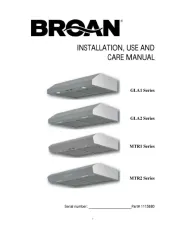
3 Juni 2025
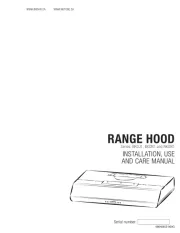
17 April 2025

17 April 2025
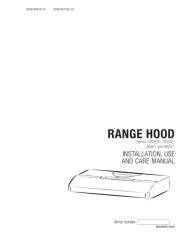
17 April 2025

17 April 2025
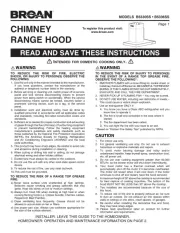
17 April 2025
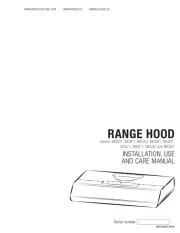
17 April 2025
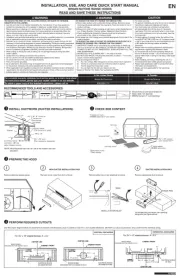
16 April 2025
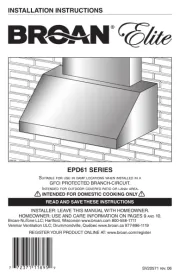
16 April 2025
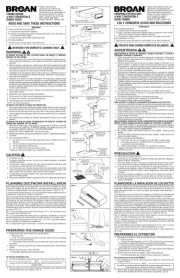
15 April 2025
Handleiding Afzuigkap
- Freggia
- Oranier
- Meireles
- Gorenje
- Candy
- Faber
- Venmar
- Ardo
- Grundig
- Hiberg
- Hanseatic
- Gutmann
- Unox
- Orbegozo
- Premium Levella
Nieuwste handleidingen voor Afzuigkap
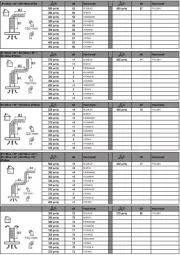
29 Juli 2025
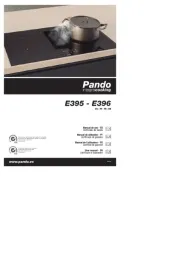
29 Juli 2025
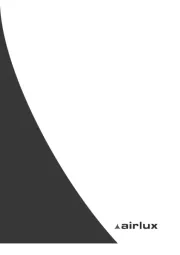
29 Juli 2025
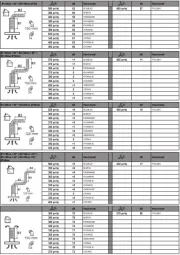
29 Juli 2025
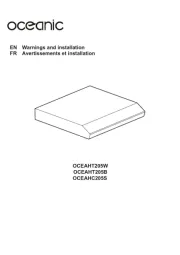
29 Juli 2025
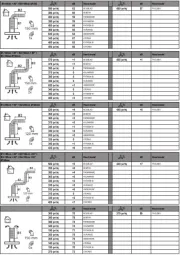
29 Juli 2025
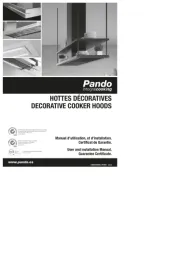
29 Juli 2025
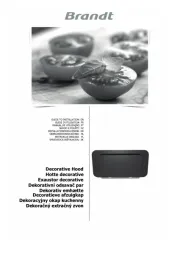
29 Juli 2025
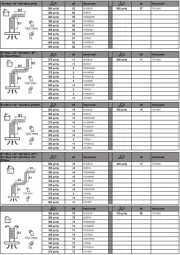
29 Juli 2025
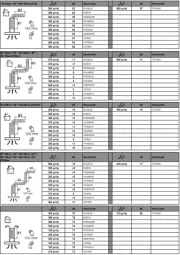
28 Juli 2025